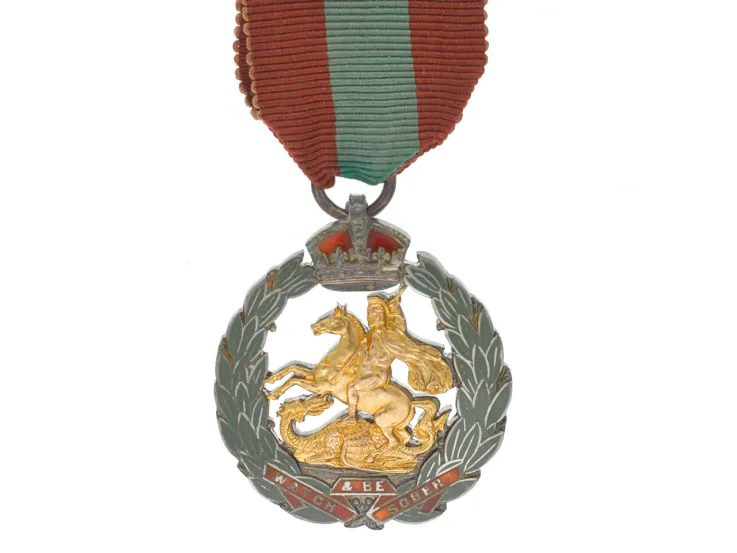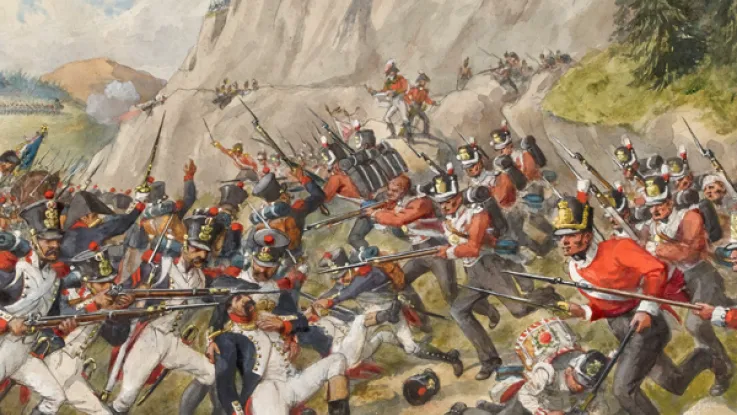Lack of recognition
Until the 19th century, the British Government rarely issued official medals to recognise the contribution of soldiers. Non-commissioned officers (NCOs) and other ranks were eligible for even fewer medals than officers, as they were perceived as merely doing their duty.
Acts of leadership or gallantry by other ranks were sometimes rewarded with promotions, annuities or pension increases, with Orders of Chivalry awarded to officers. However, this was not always the case. Many acts of bravery, as well as soldiers’ long service, went unrewarded.
Unofficial awards
Some regiments chose to address this by issuing their own awards for gallantry, participation in particular battles or campaigns, and for long service and good conduct.
Originating in the 1760s, these medals were issued at the discretion of the unit. They were usually funded by the officers themselves or by the colonel of the regiment – usually an officer of general rank who had once served with the regiment. There was no standardisation, which resulted in a great variety of different types and forms of medals.
Good conduct and long service
The earliest known example of a regimental medal seems to be the 5th (Northumberland) Regiment’s Medal of Merit. Instituted in 1767, this was awarded for good conduct. A bronze medal was issued for seven years' good conduct, followed by silver and gold medals for 14 and 21 years respectively.
Medals for continued good conduct over the course of several years are quite common. However, there are variations between those awarded by different units, including the number of years required to qualify and the designs. The 13th (1st Somersetshire) Regiment, for example, issued Medals of Merit for 7, 10, 14 and 20 years.
In 1830, the Army introduced the official Long Service and Good Conduct Medal, which is still presented today. Subsequently, regimental medals for good conduct and long service were rarely issued.
Campaigns
Other regiments issued medals for service in specific campaigns or actions. The earliest known award of this type was issued by the 40th (2nd Somersetshire) Regiment for participation in the defence of Chew’s House during the Battle of Germantown in the American War of Independence (1775-83). It appears to have been commissioned and paid for by the unit's regimental colonel, General Sir George Osborne.
The medal depicts Chew’s House under fire from American cannon. Soldiers can be seen firing from the upper floors on skirmishers approaching their position. British reinforcements are shown marching onto the field at the lower left.
Peninsula
The majority of these types of medals are associated with the Peninsular War (1808-14). By the end of this campaign, the Army Gold Medal and Cross had been instituted for officers participating in qualifying battles. But the service of NCOs and other ranks on the Peninsula was not recognised until 1847, when the Military General Service Medal was authorised for surviving veterans. As a result, there was a proliferation of regimental medals issued for the Peninsular War.
Forlorn hope
Among the best-known regimentally issued medals for the Peninsular War are the 52nd (Oxfordshire) Regiment’s Forlorn Hope Medals. These were instituted in 1820 and were awarded to personnel who had participated in the sieges of Ciudad Rodrigo, Badajoz or San Sebastian.
It was considered an act of great courage and prestige to be one of the lead troops in these attacks on breaches in enemy fortifications. The storming parties faced greater dangers than those following them. Generally, the surviving participants would be promoted or have an improved chance of promotion in the future. However, this was not guaranteed.
The 52nd are believed to be unique in issuing medals for these attacks. Prior to 1820, when the medal was approved, men of the 52nd who had taken part in the sieges of Badajoz and Cuidad Rodrigo were entitled to wear a badge on their right arms of a laurel wreath with the letters V and S at the centre, signifying them as a ‘Valiant Stormer’. Again, this honour only applied to troops of the 52nd Foot.
Connaughts and Buffs
Other unofficial Peninsular awards include the campaign medals issued to the 88th Regiment (Connaught Rangers). There were three classes of their Regimental Order of Merit: the first for participation in 12 or more actions; the second for 6-to-11 actions; and the third for fewer than six actions. Each was engraved with the name of the recipient.
The medals had some similarity to the Army Gold Medal and Army Gold Cross awarded to officers for participation in certain Peninsular actions. Once an officer had been in four actions, they would trade their Army Gold Medal in for an Army Gold Cross.
The 3rd (East Kent) Regiment (The Buffs) also awarded medals for meritorious service during the Peninsular War in a variety of different forms. Like those of the Connaught Rangers, these are frequently inscribed with the names of the qualifying battles and the recipient.
A brigade award
The Bentinck Medal was first presented in 1855 by Major-General Sir Henry Bentinck, formerly of the Coldstream Guards and commander of the Guards Brigade in the Crimea (1854-56). He intended to issue the medal in three different strikings to selected members of the three Guards regiments who had performed outstanding service, at a time when official awards for gallantry were still insufficiently available.
Ironically, no member of the Coldstreams was ever to receive the medal. The General had made the first presentation to the Grenadier Guards, whereupon the Coldstreams are said to have protested (on the grounds that the General, as an ex-Coldstream should have presented them with theirs first) and refused any awards.
There are believed to have been 13 awards made: seven to the Grenadier Guards, two of whose recipients would later receive the Victoria Cross (VC); and five to the Scots Fusilier Guards. The 13th medal went to Private John Alexander VC of the 90th Regiment (Perthshire Volunteers), who had risked his life helping to save an officer in the Scots Fusilier Guards at the Redan on 6 September 1855.
Hussars
Once official medals had been introduced, it became less common for regiments to award their own medals for merit. However, some continued to present them to exceptional individuals associated with the unit.
The 14th King’s Hussars instituted their regimental medal in 1909 to replace their older 14th Light Dragoons Medal, which had fallen into abeyance. The new award continued to be presented following the 14th’s amalgamation with the 20th Hussars in 1922.
A bar to this medal was introduced in 1946 by Lieutenant Colonel HAR Tilley for a second qualifying activity in a different part of regimental life. Altogether, 176 medals and 13 bars had been awarded by the time the 14th/20th King’s Hussars were themselves amalgamated into the King’s Royal Hussars in 1992.
The new unit continued to award the 14th/20th King’s Hussars medal to individuals within (or attached to) the regiment who contributed to the military efficiency or honour of the King's Royal Hussars.
Modern awards
The Yorkshire Regiment has also continued to award regimental medals to exceptional personnel, including Honorary Colonel Sir Tom Moore. He received the unit's Annual Regimental Medal for his fundraising efforts in support of NHS charities during the Covid-19 pandemic in 2020.
Regiments still award medals to commemorate significant events within their history. These could be tied to battles, such as the Blues and Royals medal produced for the 200th Anniversary of the Battle of Waterloo, or significant regimental events, like the Royal Highland Fusiliers Medal issued in 2009 to commemorate the regiment's 50th anniversary.
Military skills
The most common regimental medals, however, were those awarded for military skills or sporting achievement.
Awarding medals for outstanding swordsmanship, drill, marksmanship and horsemanship within or between regiments, recognised the importance of these skills. Rewarding high achievers also helped to improve standards across the board by creating a competitive atmosphere.
Sport
Army sport prepared soldiers for combat by increasing fitness, channelling aggression, and focusing the mind. Sport served to strengthen the ties between troops, instilling discipline and readiness to serve a common cause. It was also a useful way of keeping troops occupied and out of the tavern or brothel.
Sporting contests between units also fostered faith in the regiment or corps, reinforced group identity and made soldiers ready to serve a shared cause, even in the most difficult circumstances.
Pride
Owing to increased levels of official recognition for gallantry, long service, good conduct and campaign service, there has been a significant reduction in the number and variety of medals awarded by different regiments. But the tradition still survives.
Regimental medals are still a great source of pride for their recipients. And, with their increasing rarity, the honour of receiving one has become greater.























